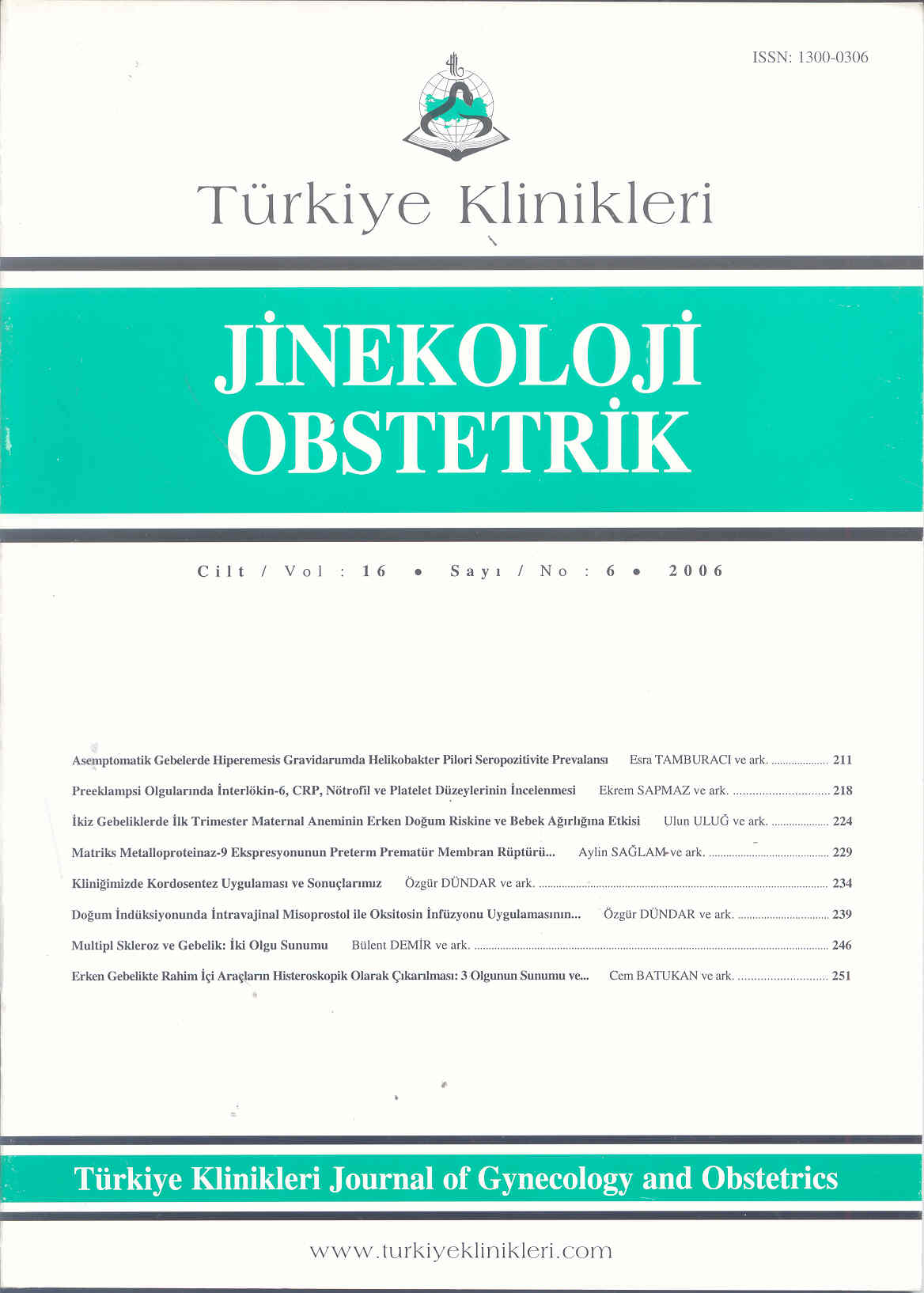Open Access
Peer Reviewed
ORIGINAL RESEARCH
3467 Viewed1237 Downloaded
Prevalence Of Helicobacter Pylori Seropositivity In Asymptomatic Pregnant Women And Hyperemesis Gravidarum
Asemptomatik Gebelerde Hiperemesis Gravidarumda Helikobakter Pilori Seropozitivite Prevalansı
Turkiye Klinikleri J Gynecol Obst. 2006;16(6):211-7
Article Language: TR
Copyright Ⓒ 2025 by Türkiye Klinikleri. This is an open access article under the CC BY-NC-ND license (http://creativecommons.org/licenses/by-nc-nd/4.0/)
ÖZET
Amaç: Serolojik test sonuçları kullanılarak ilk trimester gebelikte Helikobakter pilori (Hp) seropozitifliği prevalansını araştırmayı hedefledik. Gereç ve Yöntemler: Çalışmaya, gebeliğin ilk trimesterinde olan 50 hiperemesis gravidarum (HG) hastası ile aynı gebelik haftasında olan 250 hasta dahil edildi. Olgulardan alınan serum örneklerinde Hp için spesifik antikorların varlığı araştırıldı (IgG, IgA). Gruplardan elde edilen verinin istatistiksel analizi ?2 testi kullanılarak yapıldı. Bulgular: Çalışma ve kontrol grupları arasında demografik karakterler açısından istatistiksel olarak anlamlı fark saptanmadı (p> 0.05). Hp enfeksiyonu seropozitifliği, hiperemesis gravidarum grubunda %88, kontrol grubunda %44 idi. Aradaki fark istatistiksel olarak anlamlı bulundu (p< 0.001). Sonuç: Çalışmamızda hiperemesis gravidarumla Hp enfeksiyonu arasındaki ilişki istatistiksel olarak anlamlı bulundu. Hp, hiperemesis gravidarum patogenezinden sorumlu faktörlerden biri olarak kabul edilmeli ve bu hasta grubunda mutlaka araştırılmalıdır.
Amaç: Serolojik test sonuçları kullanılarak ilk trimester gebelikte Helikobakter pilori (Hp) seropozitifliği prevalansını araştırmayı hedefledik. Gereç ve Yöntemler: Çalışmaya, gebeliğin ilk trimesterinde olan 50 hiperemesis gravidarum (HG) hastası ile aynı gebelik haftasında olan 250 hasta dahil edildi. Olgulardan alınan serum örneklerinde Hp için spesifik antikorların varlığı araştırıldı (IgG, IgA). Gruplardan elde edilen verinin istatistiksel analizi ?2 testi kullanılarak yapıldı. Bulgular: Çalışma ve kontrol grupları arasında demografik karakterler açısından istatistiksel olarak anlamlı fark saptanmadı (p> 0.05). Hp enfeksiyonu seropozitifliği, hiperemesis gravidarum grubunda %88, kontrol grubunda %44 idi. Aradaki fark istatistiksel olarak anlamlı bulundu (p< 0.001). Sonuç: Çalışmamızda hiperemesis gravidarumla Hp enfeksiyonu arasındaki ilişki istatistiksel olarak anlamlı bulundu. Hp, hiperemesis gravidarum patogenezinden sorumlu faktörlerden biri olarak kabul edilmeli ve bu hasta grubunda mutlaka araştırılmalıdır.
ANAHTAR KELİMELER: Helikobakter pilori, hiperemesis gravidarum, ilk trimester gebelik
ABSTRACT
Objective: To investigate the prevalence of Helicobacter pylori (Hp) seropositivity in the first trimester of pregnancy by using serologic test results. Material and Methods: Fifty pregnant women with hyperemesis gravidarum (HG) and 250 asymptomatic pregnant women of matching gestational age without hyperemesis symptoms were enrolled in this prospective study. Serum samples collected from cases were investigated in terms of specific antibodies for Hp (immunoglobulin-IgG, IgA). Statistical analysis of the data obtained from the groups was made by appropriate ?2 tests. Results: There was no statistically significant difference in the demographic characteristics between the study and the control groups (p> 0.05). The prevalance of Hp seropositivity was 82% and 44% in hyperemesis gravidarum patients and the control group respectively. The difference was statistically significant (p< 0.001). Conclusion: Hp infection was found to be significantly associated with hyperemesis gravidarum in our study. We suggest chronic infection of Hp should be considered as one of the important factors on the pathogenesis of hyperemesis gravidarum even though it may not be the single cause of the disorder.
Objective: To investigate the prevalence of Helicobacter pylori (Hp) seropositivity in the first trimester of pregnancy by using serologic test results. Material and Methods: Fifty pregnant women with hyperemesis gravidarum (HG) and 250 asymptomatic pregnant women of matching gestational age without hyperemesis symptoms were enrolled in this prospective study. Serum samples collected from cases were investigated in terms of specific antibodies for Hp (immunoglobulin-IgG, IgA). Statistical analysis of the data obtained from the groups was made by appropriate ?2 tests. Results: There was no statistically significant difference in the demographic characteristics between the study and the control groups (p> 0.05). The prevalance of Hp seropositivity was 82% and 44% in hyperemesis gravidarum patients and the control group respectively. The difference was statistically significant (p< 0.001). Conclusion: Hp infection was found to be significantly associated with hyperemesis gravidarum in our study. We suggest chronic infection of Hp should be considered as one of the important factors on the pathogenesis of hyperemesis gravidarum even though it may not be the single cause of the disorder.
MENU
POPULAR ARTICLES
MOST DOWNLOADED ARTICLES





This journal is licensed under a Creative Commons Attribution-NonCommercial-NoDerivatives 4.0 International License.










